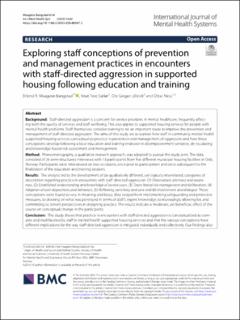| dc.contributor.author | Maagerø-Bangstad, Erlend Rinke | |
| dc.contributor.author | Sælør, Knut Tore | |
| dc.contributor.author | Lillevik, Ole Greger | |
| dc.contributor.author | Ness, Ottar | |
| dc.date.accessioned | 2020-08-27T07:46:09Z | |
| dc.date.available | 2020-08-27T07:46:09Z | |
| dc.date.created | 2020-08-03T15:11:19Z | |
| dc.date.issued | 2020 | |
| dc.identifier.citation | International Journal of Mental Health Systems. 2020, 14 (60) | en_US |
| dc.identifier.issn | 1752-4458 | |
| dc.identifier.uri | https://hdl.handle.net/11250/2675306 | |
| dc.description.abstract | Background
Staff-directed aggression is a concern for service providers in mental healthcare, frequently affecting both the quality of services and staff wellbeing. This also applies to supported housing services for people with mental health problems. Staff themselves consider training to be an important route to improve the prevention and management of staff-directed aggression. The aims of this study are to explore how staff in community mental health supported housing services conceptualize practice in prevention and management of aggression and how these conceptions develop following a local education and training endeavor in disempowerment-sensitive, de-escalating and knowledge-based risk assessment and management.
Method
Phenomenography, a qualitative research approach, was adopted to pursue the study aims. The data consisted of 26 semi-structured interviews with 13 participants from five different municipal housing facilities in Oslo, Norway. Participants were interviewed on two occasions, once prior to participation and once subsequent to the finalization of the education and training sessions.
Results
The analysis led to the development of six qualitatively different, yet logically interrelated, categories of description regarding practice in encounters with staff-directed aggression: (1) Observation, alertness and awareness, (2) Established understanding and knowledge of service users, (3) Team-based risk management and deliberation, (4) Adaption of own dispositions and behaviors, (5) Reflexivity, sensitivity and care and (6) Involvement and dialogue. These conceptions were found to vary in meaning and focus; they ranged from implementing safeguarding and protective measures, to drawing on what was portrayed in terms of staff’s expert knowledge, to increasingly allowing for, and committing to, tenant perspectives in designing practice. The results indicate a moderate, yet beneficial, effect of the course on conceptual change in the participants.
Conclusion
This study shows that practice in encounters with staff-directed aggression is conceptualized as complex and multifaceted by staff in mental health supported housing services and that the various conceptions have different implications for the way staff-directed aggression is mitigated individually and collectively. Our findings also suggest that it is beneficial to take conceptual variation regarding practice into consideration when devising education and training aimed at enhancing staff knowledge, skills and practices. | en_US |
| dc.language.iso | eng | en_US |
| dc.publisher | BioMed Central | en_US |
| dc.rights | Navngivelse 4.0 Internasjonal | * |
| dc.rights.uri | http://creativecommons.org/licenses/by/4.0/deed.no | * |
| dc.title | Exploring staff conceptions of prevention and management practices in encounters with staff-directed aggression in supported housing following education and training | en_US |
| dc.type | Peer reviewed | en_US |
| dc.type | Journal article | en_US |
| dc.description.version | publishedVersion | en_US |
| dc.source.volume | 14 | en_US |
| dc.source.journal | International Journal of Mental Health Systems | en_US |
| dc.source.issue | 60 | en_US |
| dc.identifier.doi | https://doi.org/10.1186/s13033-020-00387-2 | |
| dc.identifier.cristin | 1821393 | |
| dc.description.localcode | Open Access This article is licensed under a Creative Commons Attribution 4.0 International License, which permits use, sharing, adaptation, distribution and reproduction in any medium or format, as long as you give appropriate credit to the original author(s) and the source, provide a link to the Creative Commons licence, and indicate if changes were made. The images or other third party material in this article are included in the article's Creative Commons licence, unless indicated otherwise in a credit line to the material. If material is not included in the article's Creative Commons licence and your intended use is not permitted by statutory regulation or exceeds the permitted use, you will need to obtain permission directly from the copyright holder. To view a copy of this licence, visit http://creativecommons.org/licenses/by/4.0/. The Creative Commons Public Domain Dedication waiver (http://creativecommons.org/publicdomain/zero/1.0/) applies to the data made available in this article, unless otherwise stated in a credit line to the data. | en_US |
| cristin.ispublished | true | |
| cristin.fulltext | original | |
| cristin.qualitycode | 1 | |

